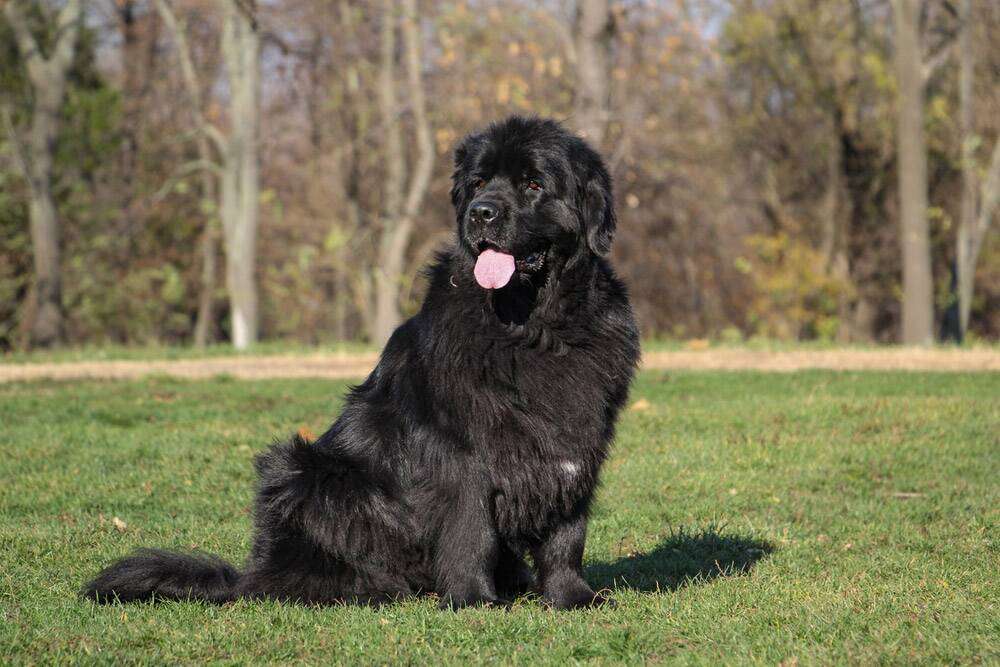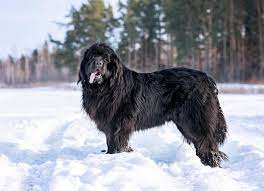People often refer to the Newfoundland dog as a ‘gentle giant’ due to its calm nature, sturdy build, and strong swimming ability. Breeders originally developed this large working breed in Newfoundland, Canada, to help fishermen, and today, many families around the world welcome them as beloved pets.

Origin and History
The Newfoundland dog originated in the Canadian region of Newfoundland, where it was developed to work alongside fishermen. It was developed to help fishermen with tasks like pulling nets, carrying heavy loads, and rescuing people from the water.
Learn more about: Goldendoodle dog breed guide
Settlers in the 17th century brought European breeds like the Great Pyrenees and Portuguese Water Dog, which they likely mixed with local dogs to develop this breed. Their dense, water-resistant coat and webbed feet helped them thrive in the cold, rough conditions of the North Atlantic.
Physical Characteristics
- Size: Giant
- Weight: 100–150 pounds (45–68 kg)
- Height: 26–28 inches (66–71 cm)
- Coat: Thick, double-layered, water-resistant
- Colors: Black, brown, gray, Landseer (white with black patches)
Newfoundlands have strong, muscular bodies with broad chests and large heads.Their big size is balanced by a calm and patient nature, making them good companions for families with children and other pets.
Temperament and Personality
Known for their warm-hearted nature, strong loyalty, and calm demeanor, Newfoundlands make wonderful companions. Despite their large size, they are friendly and calm. Here are some of their key traits:
- Affectionate: They bond strongly with their families and enjoy being around kids.
- Known for their kindness and patience, they are often called ‘nanny dogs’ due to their gentle and nurturing nature.
- Protective: They are watchful and can act as good guardians, though they are not typically aggressive.
- Intelligent: These dogs are quick to learn and respond well to positive training.
- Quiet by nature, they tend to be calm and well-behaved around the house.
Exercise Needs
Newfoundlands are not as energetic as some other working breeds, but they still need daily exercise to remain healthy and happy.
Recommended activities include:
- Daily walks
- Swimming (their favorite!)
- Light playtime
- Fetch and tug games
Puppies should not be over-exercised until their joints are fully developed.
Grooming and Maintenance
Newfoundlands have a dense, double-layered coat that needs consistent grooming to stay healthy and tangle-free.
Important grooming tasks include:
- Regular brushing two to three times per week helps reduce shedding and prevents mats in their coat.
- Bathing: Every few months or as needed.
- Ear cleaning: Weekly to prevent infections, especially since their ears are floppy.
- Nail trimming: Monthly or as needed.
- Dental care: Brush teeth several times a week to avoid tartar buildup.
They shed a lot, especially in the spring and fall, so expect extra vacuuming.
Health and Lifespan
Similar to other large dog breeds, Newfoundlands can be vulnerable to certain health problems. Responsible breeding and regular vet care can help improve their health and longevity.
Common Health Concerns:
- Hip and elbow dysplasia
- Heart disease (Subvalvular Aortic Stenosis – SAS)
- Cystinuria (a genetic kidney condition)
- Obesity
- Bloat (Gastric torsion)
Average Lifespan:
- 8–10 years
Diet and Nutrition
Newfoundlands need a balanced, high-quality diet to support their large size.
Important feeding tips include:
- Use large-breed puppy food to encourage controlled, healthy development during the early growth stages.
- Portion control is essential to prevent obesity.
- Avoid high-fat treats and table scraps.
- Always provide fresh water.
- Consult your vet to determine the best feeding plan based on your dog’s age and activity level.
Training and Socialization
Because they are intelligent and motivated to please, Newfoundlands usually learn commands quickly and train well. However, their size makes it essential to start obedience training and socialization early. Teach them basic commands like:
- Sit
- Stay
- Down
- Come
- Leave it
Socialize them with different people, pets, and environments from an early age to help them become well-rounded and well-behaved.
Living Conditions
While they enjoy being outdoors, Newfoundlands aren’t suited for hot climates due to their thick coats.
Ideal living situations include:
- Homes with large yards
- Cooler climates
- Access to water for swimming
- Families that are home often (they do not do well when left alone for long periods)
They can live in apartments if given enough exercise, but their size may make space an issue.
Is the Newfoundland Dog Right for You?
A Newfoundland dog could be a great choice if you are looking for:
- ✅ A gentle and affectionate family pet
- ✅ A patient companion for kids
- ✅ A strong swimmer and outdoor partner
- ✅ A loyal and protective dog at home
That said, they might not be ideal for those who:
- ❌ Live in a hot climate
- ❌ Have limited space
- ❌ Can not commit to regular grooming
- ❌ Prefer a low-shedding breed
Fun Facts About the Newfoundland Dog
- They have webbed feet, which help them swim better.
- A Newfoundland famously rescued Napoleon Bonaparte from drowning.
- The breed appears in literature, including J.M. Barrie’s Peter Pan, the family dog Nana is depicted as a Newfoundland.
- They are often used in water rescue operations because of their strength and swimming ability.
Conclusion
The Newfoundland dog is a majestic and kind-hearted companion that brings warmth and security to any home. Whether you are seeking a loyal family dog, a gentle playmate for children, or a strong swimmer for outdoor activities, this breed fits the bill. Be prepared for some grooming, occasional drooling, and plenty of love.


Pingback: Labradoodle: The Smart, Friendly, and Hypoallergenic Family Dog -